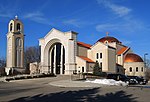Van Gelder Studio
1959 establishments in New JerseyAlbums recorded at Van Gelder StudioCompanies based in Bergen County, New JerseyEnglewood Cliffs, New JerseyMass media in New Jersey ... and 3 more
National Register of Historic Places in Bergen County, New JerseyNew Jersey Register of Historic PlacesRecording studios in the United States

The Van Gelder Studio is a recording studio at 445 Sylvan Avenue, Englewood Cliffs, New Jersey, United States. Following the use of his parents' home at 25 Prospect Avenue, Hackensack, New Jersey, for the original studio, Rudy Van Gelder (1924–2016) moved to the new location for his recording studio in July 1959. It has been used to record many albums released by jazz labels such as Blue Note, Prestige, Impulse!, Verve and CTI. It was added to the National Register of Historic Places on April 25, 2022, for its significance in performing arts and engineering.
Excerpt from the Wikipedia article Van Gelder Studio (License: CC BY-SA 3.0, Authors, Images).Van Gelder Studio
Hudson Terrace,
Geographical coordinates (GPS) Address Nearby Places Show on map
Geographical coordinates (GPS)
| Latitude | Longitude |
|---|---|
| N 40.87582 ° | E -73.95156 ° |
Address
Hudson Terrace 400
07632
New Jersey, United States
Open on Google Maps




